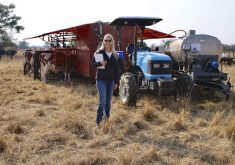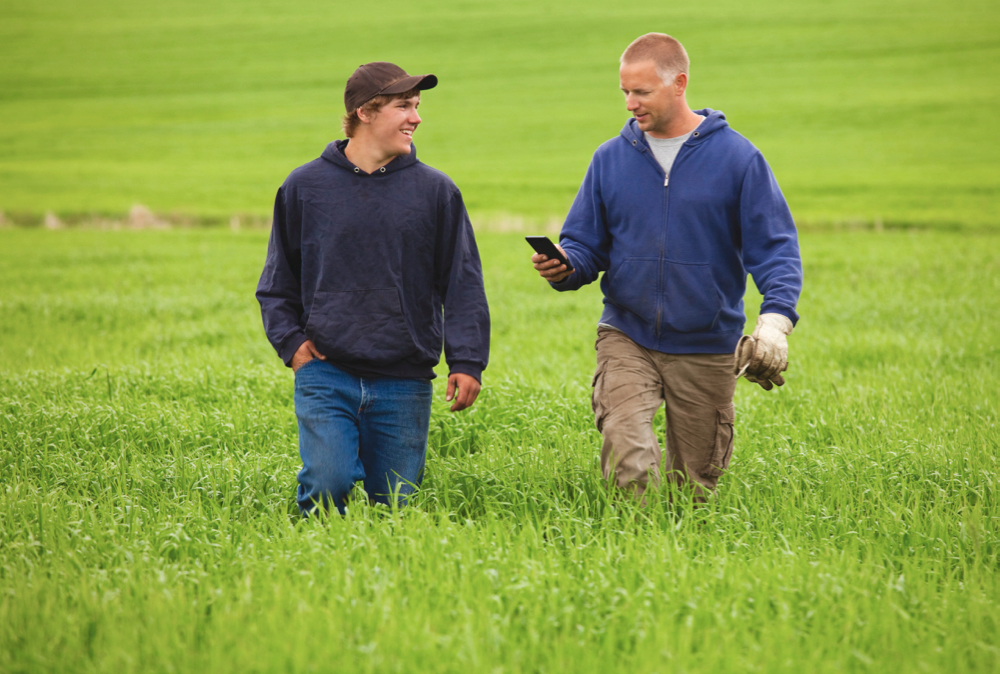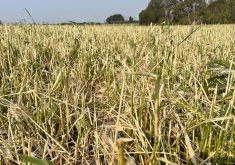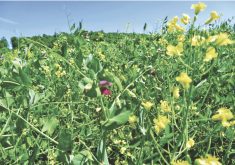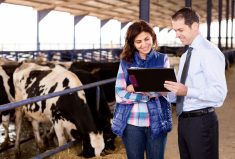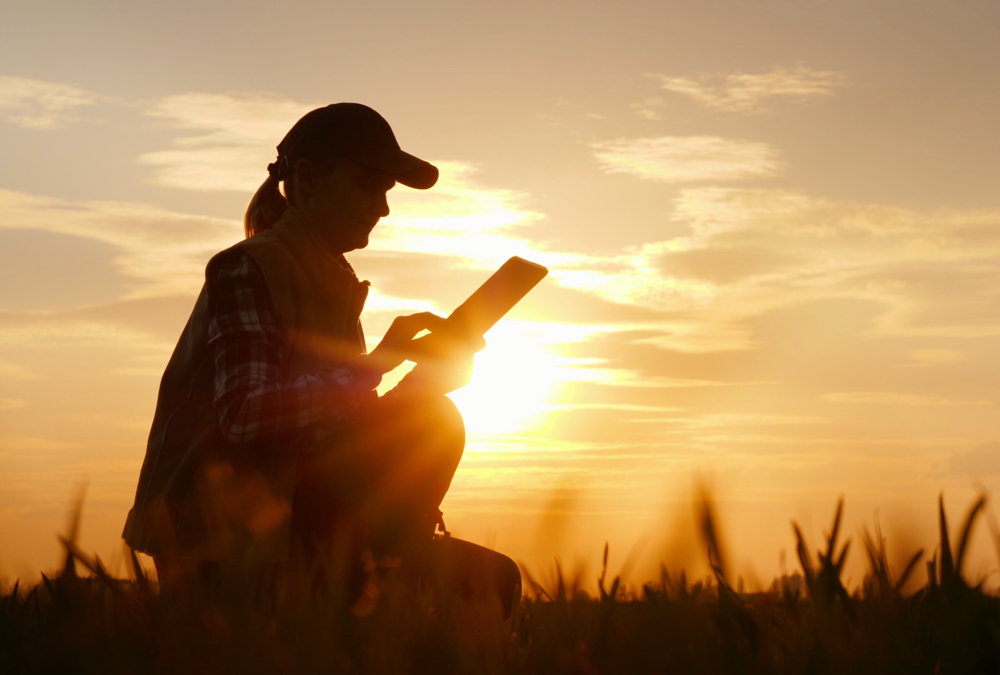Ask Keith Currie where the biggest risk lies, and he’ll point to the sky. “We’re seeing much more severe weather systems, whether it’s cold snaps, dry snaps, wet snaps. The weather patterns are moving differently,” says Currie, who grows hay and sweet corn near Collingwood, Ont., where he is president of the Ontario Federation of Agriculture.
This fall, too, farmers in parts of Alberta were struggling for the second year in a row to finish harvest, and Barbara King was seeing the challenge for her farm clients from her office as a partner in accounting firm BDO’s Red Deer location.
Read Also

Riding the tariff rollercoaster
Farmers are accustomed to roller-coaster years. But the current geopolitical windstorm is something else entirely. On his cattle operation near…
In a way, she knows, it can seem there’s nothing new in the risk of bad weather, and the way those risks should be handled. Today’s government crop insurance has its roots in the federal Crop Insurance Act of 1959. And in 2016-17, over 70,000 farms across Canada enrolled in AgriInsurance to cover production losses caused by natural hazards in crops ranging from canola to eggplants.
But combine those shifting weather patterns with thinner profit margins and growing farm size, and things look dicier.
“The total dollars involved in your business are just that much higher,” agrees Currie.
Of course, weather is far from the only risk that farmers face. Worldwide, farmers are breaking new land and growing new crops, increasing the competition for Canadian farmers.
Todd Lewis, Agricultural Producers Association of Saskatchewan (APAS) president and southern Saskatchewan farmer, also sees more biosecurity risks in agriculture these days. Manitoba’s pork producers have been struggling for several months to contain porcine epidemic (PED) virus, he points out, while on the crop side, producers are dealing with clubroot in canola.
While some of those risks were probably always present, Lewis sees them as more prominent today.
“That’s the world we live in now,” Lewis says.
North American Free Trade Association (NAFTA) negotiations are making everyone nervous too, says Dan Mazier, president of Manitoba’s Keystone Agricultural Producers. Mazier has been farming since 1985, and he remembers how public opinion was against NAFTA when it was first negotiated. Today, public opinion has done a 360 on the trade deal, he says.
Mazier acknowledges NAFTA needs updating. It’s a different world than when the agreement first came in. But the framework is still sound, he feels, and he foresees a lot of uncertainty if the U.S. withdraws.
And such a withdrawal is looking more possible to Alan Ker, director of the University of Guelph’s Institute for the Advanced Study of Food and Agricultural Policy. “A month or two ago, I thought differently, that it was probably all going to get worked out,” Ker says. “But now I’m less certain on that.”
Will Canadian producers be protected if NAFTA dies on the operating table? Would a program such as AgriStability kick in? Mazier for one isn’t sure how it would fall out if the U.S. imposes new tariffs. The program needs to be more predictable, he says.
Ker suspects livestock producers might be harder hit than crop producers. And there’s no way to hedge against that, he says, because policy changes can create price risks that affect producers for years. After all, a trade deal isn’t going to be renegotiated each year.
Nor is Ker sure the government can create a program to handle those risks. Even if AgriStability had a higher limit, it would only help with the first year or two. Beyond that, farmers would have a new, lower guarantee.
As for Lewis, he’s not sure how the government could create a program to protect producers from the worst case scenario, such as a border closure. But it would need to pitch in for the industry to survive.
“If tomorrow all agricultural trade ceased between Canada, U.S., and Mexico, it would have a pretty heavy impact on everybody and it would take some time to sort everything out,” says Lewis. “At that point you would hope the government would be there to support the industry.”
What to do with AgriStability
Earlier, Ker spent 12 years at the University of Arizona where he studied crop insurance programs. Arizona’s program resembles Canada’s AgriInsurance program, he says, and farmers are generally happy with crop insurance in both places.
But are there other places where an AgriStability-like program is working?
“Most developed countries have stayed with a commodity-specific program and a crop-specific program, whereas AgriStability is trying to do a whole farm,” says Ker. Those places that do have a whole-farm program haven’t seen much uptake, he adds.
“So it hasn’t been successful in other places either.”
Farm leaders say AgriStability participation has been nose-diving, and the numbers certainly don’t look good. Agriculture and Agri-Food Canada reports 57,000 producers with gross farm revenue over $10,000 enrolled in AgriStability in 2014.
In contrast, AgriInvest has proved popular due to its predictability and ease of use. In 2014, 129,000 producers with gross farm revenue over $10,000 participated.
In Lewis’s view, farmers have voted with their feet on AgriStability.
Farmers and farm advisers interviewed for this story listed several reasons for declining enrolment rates. The required paperwork is onerous and confusing. The new payment trigger at 70 per cent of a producer’s historical reference margins means farmers are much less likely to get a payout, and producers don’t receive payments until months after the money is needed.
Plus, the program seems unpredictable, and many producers can’t see a scenario where it would be relevant to their farms.
This past summer, the federal government unveiled two changes to make AgriStability more palatable, but it’s unclear if they will work. Their first was to allow late enrolment at reduced coverage levels, but Saskatchewan’s ag minister Lyle Stewart has already said his province won’t offer late enrolment, and others may follow suit.
Mazier understands Saskatchewan’s aversion towards late enrolment — it could wreak havoc with provincial budgets.
Plus, allowing people to enrol late, once they realize they’re facing a crisis, brings in an issue of fairness, Mazier adds. “It eats away at your credibility in general as an industry.”
Late deadlines aren’t the only change coming to AgriStability. Reference margins are now set firmly at 70 per cent, a change from the formula based on allowable expenses.
The old system hammered efficient farms and certain sectors, such as cow-calf producers, and farm leaders are happy to see the back of it. It “was an irritant, to say the least,” says Mazier.
But Mazier and Lewis say that positive changes affect a relatively small number of producers, and so are unlikely to boost enrolment rates substantially.
And those changes have come at the cost of AgriInvest.The federal government has reduced the allowable net sales eligibility from $1.5 million to $1 million. Annual government matching contributions will drop from $15,000 to $10,000.
Lewis expects many producers will question trying to fix AgriStability at the cost of AgriInvest. Currie worries that limiting contributions to AgriInvest will affect participation. And Mazier says that although farm leaders wanted to see AgriStability shored up, and although they know money is tight, “it’s a tough pill to swallow.”
However, they might have a chance to change all that, as a business risk management program review gets underway this winter. Farm leaders are gearing up for meetings with provincial and federal government officials, in the hope they can all come up with a better version of AgriStability by next summer. At press time, producer groups were still setting up a governance model and scheduling meetings with federal and provincial government officials.
“I don’t think it has to be a win-or-lose situation here. Hopefully we can get it so both sides see some improvements in the program,” says Lewis.
Bumping the margins back up to 85 per cent would likely attract producers to the program again, but farm leaders are unsure whether the government has the appetite for that change. And farm groups don’t seem to be looking for quick fixes. The review must be comprehensive if it’s going to be meaningful, Mazier says.
King would like to see changes to ease the filing requirements for AgriStability. Right now, producers have to fill out forms in September related to the previous year.
“If they don’t have the proper record-keeping, a lot of them are just winging it,” she says. She notes this is particularly difficult for cattle producers. They need an opening inventory, and then need to track when steers go to market and when heifers become cows, as well as any losses.
King would like to see government agencies release inventory management systems or guidelines.
Ker wants to see a better version of AgriStability, too. An effective program could especially benefit livestock producers, he says.
Rather than basing the program on net margins, Ker suggests using gross margins. Costs could be based on representative numbers from the producer’s county or municipality. And producers wouldn’t have to wait for income tax records.
“Then it could be payable right away, like AgriInsurance.”
Managing risk on the farm
There is no magic bullet to take down risk, Ker says. For example, on-farm diversification mitigates volatility, but the tradeoff is an average income drop. Farmers have gotten “very, very good at” managing that tradeoff, Ker says. And AgriStability aside, the business risk management programs “help tremendously with that,” he says.
These days, farmers have options. Producers look at both public and private programs to cover risk, says Lewis. “There are some private programs — GARS (Global Ag Risk Solutions) and Just Solutions — that have been on the market.”
Currie sees adopting technology as a way to mitigate risk as well. Seeding technology, improved plant genetics, and better weather apps all help, he says. “We’re using our tools more wisely to grow better crops.”
He also counts the Comprehensive Economic and Trade Agreement with Europe as an upside. He’s glad to see the Trans-Pacific Partnership negotiations moving forward, too, and hopes progress is steady.
Although trade risks are out of producers’ hands, King says producer groups are improving their marketing, something she sees as positive as well.
Will that be enough for farmers to manage risk in the future? Currie says he hopes so. “But if you could tell me what the next 20 years of weather’s going to be like…”
Ker points out too that technology has not only increased productivity, but has made that productivity more volatile too.
Seeding technology, for example, allows farmers to plant more seeds per acre. More plants per acre mean more water is needed to grow that crop. That makes a moisture shortage more crucial for densely seeded acres. If a farmer doesn’t have irrigated land, and is used to drought once every 20 years, they might see a moisture shortage once every seven years instead.
“The interrelationship between technology and climate has increased the volatility, not necessarily because of climate change, but because the newer technology is a little more susceptible,” says Ker.
As for King, she sees good financial reporting as one way to help producers navigate AgriStability-type programs and manage their risks. She suggests breaking financial statements into input costs, capital costs, and operating costs.
“That really shows them what’s fixed and out of their control versus some of the things they can do,” says King.
For producers struggling with financial reporting, accountants can recommend better tools for bookkeeping, or help them develop a system to stay current.
King seems confident in producers’ ability to adapt, saying “when you think about the last 20 years and how far our producers have come as far as technology and equipment, they’ve done an excellent job in moving with the world and the competition they have to face.”
Should you stay or should you go?
AgriStability used to be a popular program with accountant Barbara King’s farm clients. Then the reference margins dropped from 85 per cent to 70 per cent.
“And quite honestly, a lot of my farmers dropped out at that point,” the Alberta-based farm adviser says. “They just felt that the program was a little bit too onerous and the filing requirements were quite large.”
King counts mixed farms, crop producers, cattle producers, and feedlots among her agricultural clients. Many of her producers are fairly well-diversified, she says. None of her clients are in supply-managed sectors.
And for many of them, they can likely get away with opting out of AgriStability, she says.
Smaller producers can cover much of their risk with traditional crop and cattle insurance. For larger farms, products such as Global Ag Risk Solutions (GARS) are an option.
For producers who are strictly feedlots, it might make sense to stay in AgriStability, she says. But with third-party insurance available, many have opted out.
“I think our farmers are becoming more and more sophisticated, and they know a lot of the tools and the products out there,” she says, adding that government programs are becoming less of a factor in producers’ risk reduction strategies.
Even so, opting out of AgriStability isn’t a decision to be taken lightly. King and her colleagues go through two years’ worth of financial statements with farm clients to help them make that decision.
They also look at comparative income statements for the last five years, she adds. That shows producers how much their margins dropped in the worst year, to see whether AgriStability makes sense.




